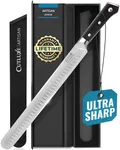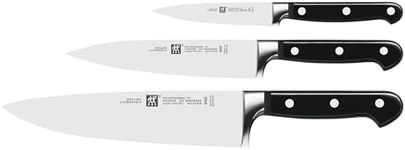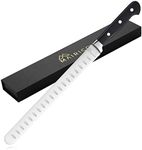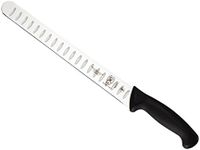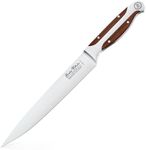Buying Guide for the Best Slicing Knives
Choosing the right slicing knife can make a significant difference in your kitchen experience. A good slicing knife will help you achieve precise cuts, making your food look and taste better. When selecting a slicing knife, consider the following key specifications to ensure you pick the best fit for your needs.Blade MaterialThe blade material is crucial as it affects the knife's sharpness, durability, and ease of maintenance. Common materials include stainless steel, high-carbon steel, and ceramic. Stainless steel is resistant to rust and easy to maintain, making it a good all-around choice. High-carbon steel is extremely sharp and holds its edge well but requires more maintenance to prevent rust. Ceramic blades are very sharp and lightweight but can be brittle and prone to chipping. Choose a material based on your willingness to maintain the knife and your preference for sharpness and durability.
Blade LengthBlade length determines how well the knife can handle different types of slicing tasks. Slicing knives typically range from 8 to 14 inches. Shorter blades (8-10 inches) are easier to control and are suitable for smaller cuts of meat and vegetables. Medium blades (10-12 inches) offer a balance between control and versatility, making them ideal for most home cooks. Longer blades (12-14 inches) are best for large cuts of meat and professional use, providing the ability to make long, smooth slices. Consider the types of food you will be slicing and choose a length that matches your needs.
Blade FlexibilityBlade flexibility affects how the knife handles different slicing tasks. A more flexible blade can make delicate cuts and follow the contours of the food, which is ideal for slicing fish or thin cuts of meat. A stiffer blade provides more control and is better suited for slicing through tougher cuts of meat or larger items. Think about the types of food you will be slicing most often and choose a blade flexibility that matches those tasks.
Handle MaterialThe handle material impacts the knife's comfort, grip, and durability. Common handle materials include wood, plastic, and composite. Wooden handles offer a traditional look and feel but require more maintenance to prevent damage from moisture. Plastic handles are durable, easy to clean, and often have a textured grip for better control. Composite handles combine the best of both worlds, offering durability and a comfortable grip. Choose a handle material that feels comfortable in your hand and suits your maintenance preferences.
Blade EdgeThe blade edge determines how the knife cuts through food. Common edge types include straight, serrated, and granton. A straight edge provides clean, precise cuts and is easy to sharpen, making it ideal for most slicing tasks. A serrated edge can cut through tougher surfaces like bread crusts and tomatoes but is harder to sharpen. A granton edge has small indentations that create air pockets, reducing friction and preventing food from sticking to the blade, which is useful for slicing thin, delicate items. Consider the types of food you will be slicing and choose an edge type that matches your needs.
